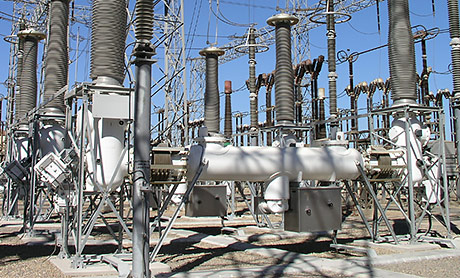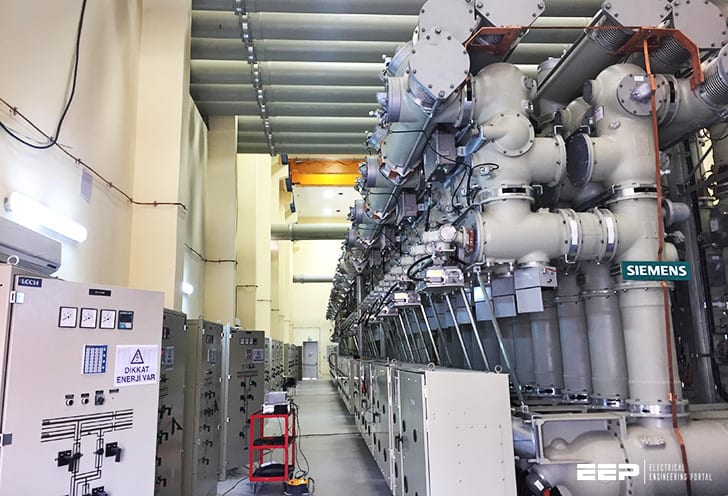A GIS substation is a power substation that uses a gas-insulated switchgear (GIS) rather than air-insulated equipment. The use of GIS equipment allows for a more compact design and higher reliability than traditional power substations.
A GIS substation is a facility where electrical power is converted from one voltage to another, or transformed to make it compatible with the local grid. Substations are also used to connect two alternating current (AC) systems of different voltages. A GIS substation uses gas-insulated switchgear (GIS), which contains all the necessary components in a single unit, rather than the traditional air-insulated switchgear (AIS).
This makes for a more efficient and reliable system.
Think you know what a Gas insulated Substation GIS is
Gis Substation Working Principle
A substation is a critical part of the electrical grid. It is where high-voltage electricity from power plants is transformed into the lower voltage used by homes and businesses. Without substations, the flow of electricity would be severely limited.
Substations come in a variety of shapes and sizes, but all have one thing in common: they contain transformers.Transformers are devices that change the voltage of an electric current. In a substation, transformers step down the high voltage coming from transmission lines to a level that can be used by distribution lines.
The first step in understanding how a substation works is to understand how a transformer works.
A transformer has two coils of wire wrapped around a metal core. The primary coil is connected to the power source, and the secondary coil is connected to the load (in this case, distribution lines). When an electric current flows through the primary coil, it creates a magnetic field around the core.
This magnetic field then induces an electric current in the secondary coil. By changing the number of turns in each coil, transformers can increase or decrease voltage levels as needed.
In most cases, there are multiple transformers at a substation connected together in what’s known as a bank configuration.
This allows for more flexibility when it comes to transforming voltages levels up or down as needed. For example, if there are twotransformers in a bank configured for “step-up” operation, they can be combined to doublethe output voltage (from 13,200 volts to 26,400 volts). Or if three “step-down”transformers are used together, they can reduce voltage by half (from 138 kilovolts[kV]to 69 kV).
Gas Insulated Substation Pdf
A gas insulated substation (GIS) uses a superior dielectric medium, sulfur hexafluoride (SF6), to insulate and isolate electrical equipment. This results in a more reliable and environmentally friendly substation.
The first GIS was installed in Switzerland in 1954.
The technology has since been adopted by utilities around the world, with more than 30,000 GIS installations currently in operation.
GIS offers many advantages over air-insulated substations (AIS). These include:
• Reduced footprint – GIS can be up to 50% smaller than an equivalent AIS. This is because the SF6 gas insulation allows for a much smaller clearances between conductors and equipment.
• Lower maintenance costs – due to the sealed nature of GIS, there is no need for regular maintenance tasks such as painting or weed control that are required with AIS.
In addition, the long service life of SF6 (up to 30 years) means that gaskets and other seals do not need to be replaced as frequently as with AIS.
• Improved reliability – the hermetically sealed design of GIS protects equipment from environmental conditions such as dust, rain, snow and ice which can lead to faults in AIS. In addition, SF6 gas has excellent arc-suppression properties which reduces the risk of outages caused by lightning strikes.
• Enhanced safety – GIS eliminates the need for dangerous high-voltage switchgear such as oil circuit breakers which are used in A1S.
Ais Substation
An AIS substation is a type of electrical substation that uses automatic isolation switches (AIS) to protect equipment and personnel from faults on the electrical grid. A typical AIS substation includes a control room, switchgear, transformers, voltage regulators, and other equipment.
The primary benefit of using an AIS substation is improved safety.
By automatically isolating faults, AIS substations can help prevent outages and reduce the risk of fire or explosion. Additionally, AIS substations can improve power quality by providing cleaner power to customers.
While AIS technology has been around for decades, it has only recently been adopted for use in electrical substations.
The increased interest in AIS substations is due to the many benefits they offer over traditional air-insulated switchgear (AIS). Some of these benefits include:
Improved Safety: As mentioned above, one of the biggest benefits of using an AIS substation is improved safety.
By automatically isolating faults, AIS substations can help prevent outages and reduce the risk of fire or explosion. Additionally, because they provide cleaner power to customers, they can also help reduce the number of service calls related to power quality issues.
Reduced Maintenance Costs: Another benefit of using an AIS substation is reduced maintenance costs.
Unlike traditional air-insulated switchgear (AIC), which requires regular maintenance and inspection due to its exposed components, there are no moving parts in an AIS system that require routine maintenance. This means that once an AIS system is installed, it will require little to no maintenance over its lifetime – resulting in significant cost savings for utility companies and their customers.
Increased Reliability: In addition to being safer and requiring less maintenance than traditional air-insulated switchgear (AIC), another big advantage of using an automated isolation system is increased reliability.
Gas Insulated Substation Wikipedia
A gas insulated substation (GIS) is a power substation in which the major equipment is surrounded by a continuous gas atmosphere, typically sulfur hexafluoride (SF6). Gas-insulated substations are used in space-constrained areas where land is expensive. They are compact and can be located almost anywhere without being affected by climate.
The main advantages of GIS over air-insulated substations (AIS) are its small footprint and high reliability due to the reduced number of joints and connections. GIS also offers many other advantages including lower costs for installation and maintenance, better safety for workers, and improved security against environmental threats such as floods or earthquakes.
Gis Substation Equipment
Substation equipment is a vital part of the electrical grid. Without it, the electricity that flows through our homes and businesses would be impossible.
GIS substation equipment is used to help manage, control, and distribute electricity.
It is made up of a variety of components, including transformers, switchgear, circuit breakers, and more. Each piece plays an important role in keeping the power flowing safely and efficiently.
To ensure that substation equipment is able to do its job properly, it must be regularly maintained and tested.
This includes everything from checking fluid levels to making sure that all parts are functioning correctly. By taking care of this equipment, we can help keep the lights on for everyone.
Gis Substation Design Pdf
A substation is a critical part of the electric power grid. Its main purpose is to take high-voltage electricity from the transmission system and distribute it to lower voltages for use by homes and businesses. A substation also serves as a switchyard, where electricity can be routed from one power line to another.
The design of a substation must take into account many factors, including the type of equipment to be used, the availability of space, the climate, and the needs of the local utility company.
In order to provide safe and reliable service, a substation must be designed according to strict engineering standards. The first step in the design process is to create a model of the proposed substation using computer software.
This model allows engineers to evaluate different design options and choose the one that best meets the needs of the project.
Once the model has been created, engineers will begin working on the detailed design of the substation. This includes choosing the specific types of equipment to be used and determining their placement within the facility.
In addition, engineers must develop specifications for all aspects of the substation’s operation, such as voltage levels, protection schemes, and control systems.
After completing these tasks, engineers will prepare drawings and documentation that will be used by construction crews to build the substation.

Credit: www.gegridsolutions.com
What Does Gis Stand for in Substation?
GIS stands for Geographical Information System. It is a system that is used to capture, store, manipulate, analyze, and present geographical data. A GIS can be used to visualize, query, and analyze data in order to better understand the relationships between different features on the earth’s surface.
What is Difference between Ais And Gis Substation?
There are many types of substations and the two main types are AIS and GIS. Both have their own unique set of benefits and drawbacks that make them ideal for different situations. Here is a quick rundown of the key differences between these two types of substations:
AIS substations are typically used for lower voltage applications, up to 138 kV. They use air-insulated switchgear, which means that the electrical components are not in contact with each other or with any conducting materials. This makes AIS substations more resistant to environmental conditions like dust, humidity, and salt spray.
However, air-insulated switchgear is also more expensive to maintain and can be less reliable than other types of switchgear.
GIS substations are typically used for medium to high voltage applications, from 138 kV up to 765 kV. They use gas-insulated switchgear, which means that the electrical components are surrounded by an insulating gas instead of air.
This makes GIS substations more compact and easier to site than AIS substations. Gas-insulated switchgear is also more reliable than air-insulated switchgear and requires less maintenance.
What are the Advantages of Gis Substation?
If you’re in the market for a new substation, you may be wondering if a GIS substation is right for you. GIS substations offer many advantages over traditional air-insulated substations (AIS), including improved reliability, reduced maintenance costs, and superior safety. Let’s take a closer look at each of these benefits:
Improved Reliability: GIS substations are less susceptible to outages caused by equipment failures. This is because the insulated gas enclosure protects critical components from exposure to the elements, which can lead to corrosion and other forms of degradation. In addition, GIS substations typically have fewer electrical connections than AIS substations, which reduces the risk of faults and shorts.
Reduced Maintenance Costs: The sealed gas environment of a GIS substation eliminates the need for regular cleaning and painting, both of which are required with an AIS substation. In addition, there are no moving parts in a GIS substation that can wear out or require replacement over time. As a result, maintenance costs for a GIS substation are typically much lower than those for an AIS station.
Superior Safety: Because there is no exposed live equipment in a GIS substation, workers can safely enter the area without fear of electrocution. This greatly reduces the risk of injury during routine maintenance and inspection activities. Additionally, should an electrical fault occur within the sealed gas enclosure, it will be isolated from people and property outside the station boundaries.
What Does Gis Stand for in Electrical Engineering?
GIS in electrical engineering stands for Geographic Information System. This system is used to manage and store geographical data. It can be used to create maps, track changes in the environment, and analyze data about specific locations.
Conclusion
GIS substation is a type of electrical substation that uses a gas-insulated switchgear (GIS) to control and protect the electrical equipment. The GIS switchgear is filled with pressurized sulfur hexafluoride (SF6) gas, which insulates the equipment from the environment and prevents arcs from occurring between the conductors.



